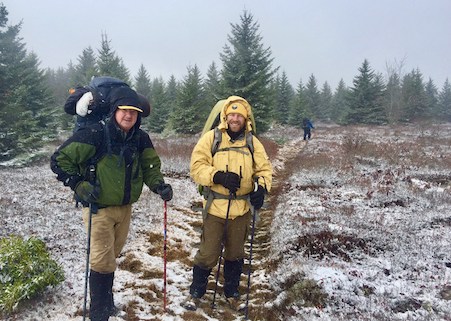
West Virginia’s Outdoor Heritage Needs Help from Our Senators
By Eric Brown
When I entered the Navy as a teenager, I didn’t know much about the world. But as a backpacker and paddler, I knew I loved West Virginia’s public lands and waters. Nearly four decades later, including 25 years running my own business, my love of this place is stronger than ever.
Spending months in a boiler room of a ship, you think about things back home. You think about what you can’t wait to see. The view from Roaring Plains, the experience of solitude in Monongahela National Forest, the sound of Seneca Creek tumbling past camp—these things are why I served.
Today I can’t get away as often as I’d like, but I still make time for an annual backpacking trip in “The Mon” with a few fellow West Virginians.
Our lands and waters mean a lot to me. That’s why I have tried to learn about them—how they are both managed and funded. I’ve learned that many of our Wild and Wonderful public lands were purchased with money from the Land and Water Conservation Fund (LWCF).
LWCF uses royalties from offshore oil and gas leases to fund recreational access on national lands, state parks and forests, and local parks. Over the last 53 years, LWCF has brought about $240 million into West Virginia. It’s been critical to The Mon, Canaan Valley and Ohio River Islands national wildlife refuges, and the Gauley and New Rivers.
In Jefferson County, it funded the expansion of Harpers Ferry National Historical Park a decade ago. That park alone has received several million dollars.
Jefferson County Parks and Recreation has obtained $336,000 from LWCF. This funding has sustained Leetown Park, Moulton Park, the new Hite Park soccer fields and shelters, and the playgrounds at South Jefferson Park and Sam Michael’s Park.
One of the benefits of public lands is what they mean for West Virginia’s economy. And I’m not talking about outfitters and raft companies. I’m talking about quality-of-life businesses. Think brew pubs, eateries, and coffee shops in the towns near public lands that couldn’t survive without travelers.
Those travelers get drawn not only by mountains and streams, but by the cool factor. They start dreaming of bringing their retirement nest eggs here; younger ones think about businesses here. Eventually, the impact becomes sustaining, and West Virginia kids think about staying and starting their own business or working their way up in another business.
We don’t necessarily think about this when we set aside public lands for enjoyment and their ecological benefits. But like any investment, the recreation access has a way of compounding interest over the long haul.
LWCF is set to expire September 30, after an extension was passed in 2015. Despite the gridlock that bogs down Congress, a lot of Representatives and Senators on both sides of the aisle agree that we need to keep this funding alive. But there are members of Congress who want to kill it or curtail it.
Senators Shelley Moore Capito and Joe Manchin have said they want LWCF permanently reauthorized. Both have co-sponsored bills to do that, and we should all be grateful for that.
Still, when the House and Senate meet to iron out the differences between whatever passes each house, we’ll need our senators to stand up for West Virginia’s heritage by standing up for permanent reauthorization of the Land and Water Conservation Fund. Find out more at www.wvpubliclands.org.
This post originally appeared in the WV Observer on August 1, 2018: https://wearetheobserver.com/west-virginias-outdoor-heritage-needs-help-senators/




